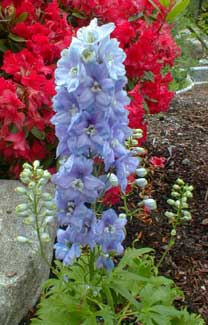
Sky Blue
Dwarf Larkspur; or,
Candle Delphinium
"Ye swinging spears of the larkspur, open your wells of gold
And pay your honey-tax to the hummingbird."
-James Oppenheim
(1882-1932)
(1882-1932)
'Sky Blue' Magic Fountain Larkspur is at maximum no more than half the size of the similarly double-flowered 'Pacific Giant.' The spikes are less than two feet over another foot of basal leaves, for a thirty-inch tall hybrid delphinium, as opposed to five to seven feet for 'Pacific Giant.' In consequence of its squat stature, it does not "lodge" or tip over as do full-sized delphiniums; it remains upright even along windy borders.
The Magic Fountain series has many colors & are long-lasting in the garden, or in bouquets. 'Sky Blue' is a pale blue with white or creamy white "bee" at the heart of each flower in the spike. These hybrids were developed form D. elatum or the Bee Larkspur native to Russia, & which grew in Thomas Jefferson's gardens. It acquired its common name because the center of each flower has two bearded petals that evoke the appearance of a bee.
Delphiniums are attractive to hummingbirds, but not to deer, as the leaves & flowers & roots are somewhat toxic. Although not generally favored by deer, elk, or rabbits, there is no accounting for individual tastes, & some deer seem to think they're tasty enough to justify a transient bellyache.
It's unfortunate they aren't also toxic to slugs, but delphiniums are slug candy, & may need protection accordingly. Their ideal USDA zones are 4-7, but can also be grown in zone 3 with heavy mulching in winter, & in Northwest Zone 8. In warmer zones, such as southern California of the American southwest, it can be grown as a winter annual.
It is sometimes recommended to plant them with tall bearded irises which typically bloom about the same time, & when the irises are finished flowering, the delphiniums can hold the location alone for color. They also look good with Golden Globeflowers or other tall flowers bright enough to hold their own for looks when competing with such brilliant big spikes.
Delphiniums are shortlived in the garden. They tend to be in their prime in their third & fourth year, then decline sometimes slowly, sometimes rapidly. It can be discouraging to wait patiently for them to become such big splendid many-spired clumps & just when they reach that level of overwhelming beauty, it's already time to start thinking of their replacements.
Whenever a clump has gotten large & tired & no longer blooms as furiously, it should be replaced, as they don't take easily to being dug up & divided (though it's worth a try if one wishes).